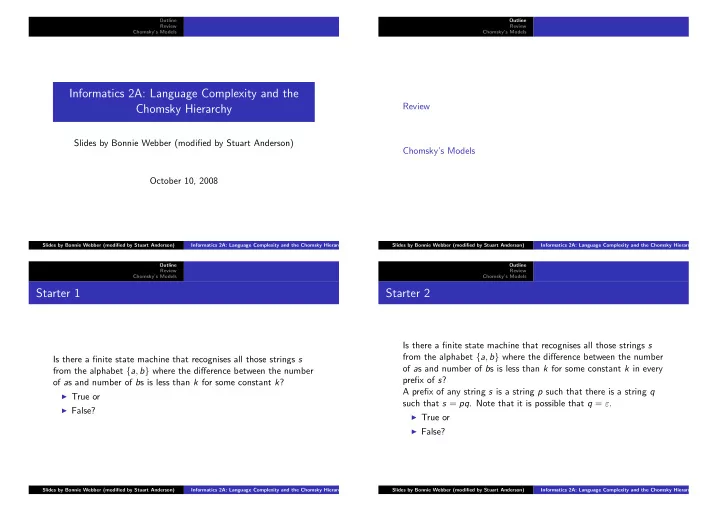

Outline Outline Review Review Chomsky’s Models Chomsky’s Models Informatics 2A: Language Complexity and the Review Chomsky Hierarchy Slides by Bonnie Webber (modified by Stuart Anderson) Chomsky’s Models October 10, 2008 Slides by Bonnie Webber (modified by Stuart Anderson) Informatics 2A: Language Complexity and the Chomsky Hierarc Slides by Bonnie Webber (modified by Stuart Anderson) Informatics 2A: Language Complexity and the Chomsky Hierarc Outline Outline Review Review Chomsky’s Models Chomsky’s Models Starter 1 Starter 2 Is there a finite state machine that recognises all those strings s from the alphabet { a , b } where the difference between the number Is there a finite state machine that recognises all those strings s of a s and number of b s is less than k for some constant k in every from the alphabet { a , b } where the difference between the number prefix of s ? of a s and number of b s is less than k for some constant k ? A prefix of any string s is a string p such that there is a string q ◮ True or such that s = pq . Note that it is possible that q = ε . ◮ False? ◮ True or ◮ False? Slides by Bonnie Webber (modified by Stuart Anderson) Informatics 2A: Language Complexity and the Chomsky Hierarc Slides by Bonnie Webber (modified by Stuart Anderson) Informatics 2A: Language Complexity and the Chomsky Hierarc
Outline Outline Review Review Chomsky’s Models Chomsky’s Models Readings and Labs Languages: Collection and Generation A formal language is the possibly infinite set of strings over a finite set of symbols (called a vocabulary or lexicon). Such strings are also called sentences of the language. Where do the sentences come from? ◮ J&M[2nd.Ed] ch. 15 (pp. 1–4) ◮ from a (finite) list – useful, but not very interesting (maybe ◮ Kozen: Lecture 21 more interesting when we have collections of really large samples of speech or text). ◮ from a grammar – abstract characterisation of the strings belonging to a language. Grammars are a generative mechanism, they give rules for generating potentially infinite collection of finite strings. Slides by Bonnie Webber (modified by Stuart Anderson) Informatics 2A: Language Complexity and the Chomsky Hierarc Slides by Bonnie Webber (modified by Stuart Anderson) Informatics 2A: Language Complexity and the Chomsky Hierarc Outline Outline Review Review Chomsky’s Models Chomsky’s Models Different kinds of Language Structure and Meaning Small red androids sleep quietly. √ Colorless green ideas sleep furiously. √ Programming language: Programmers are given an explicit grammar for the syntactically valid strings of the language that Sleep green furiously ideas colorless. ♯ Mary persuaded John to wash himself with lavender soap. √ they must adhere to. Mary persuaded John to wash herself with lavender soap. ♯ Human language: Children hear/see sentences of a language (their Mary persuaded John to wash her with lavender soap. √ “mother tongue” or other languages used at home or in their Mary promised John to wash herself with lavender soap. √ community) and are sometimes (but not always!) corrected if a string they generate isn’t in the language. Mary promised John to wash himself with lavender soap. ♯ Mary promised John to wash him with lavender soap. √ Without being given an explicit grammar, how do children learn a grammar(s) for the infinite number of ◮ Characterising child language acquisition is one goal of sentences that belong to the language(s) they speak and Linguistics. understand? ◮ Characterising language learnability (grammar induction) is one goal of Informatics. Slides by Bonnie Webber (modified by Stuart Anderson) Informatics 2A: Language Complexity and the Chomsky Hierarc Slides by Bonnie Webber (modified by Stuart Anderson) Informatics 2A: Language Complexity and the Chomsky Hierarc
Outline Outline Review Review Chomsky’s Models Chomsky’s Models Natural and Formal Languages Questions We heard from Lecture 2 that grammars differ in their complexity. More broadly, the goals of Linguistics are to characterise: ◮ What is complex about a complex grammar? ◮ individual languages: figuring out and specifying their sound ◮ How does adding a data structure to an automaton allow its systems, grammars, and semantics; corresponding grammar to be more complex? ◮ how children learn language and what allows them to do so; ◮ How does removing limits on how the store on an automaton ◮ the social systems of language use; is accessed allow its corresponding grammar to be more ◮ how individual languages change over time, and how new complex? languages arise. ◮ Is there any relationship between language complexity and Work on formal languages in Informatics contributes to achieving how hard a language is to learn? these goals through Chomsky’s desire to find a “simple and revealing” grammar that ◮ clear computational methods of characterising the complexity generates exactly the sentences of English led him to the discovery of languages; that some models of language were more powerful than others. ◮ clear computational methods for processing languages; [Noam Chomsky, Three Models for the Description of Language, ◮ clear computational theories of language learnability. IRE Transactions on Information Theory 2 (1956), pp. 113–124.] Slides by Bonnie Webber (modified by Stuart Anderson) Informatics 2A: Language Complexity and the Chomsky Hierarc Slides by Bonnie Webber (modified by Stuart Anderson) Informatics 2A: Language Complexity and the Chomsky Hierarc Outline Review Chomsky’s Models Noam Chomsky ◮ Credited with the creation of the theory of generative grammar ◮ Significant contributions to the field of theoretical linguistics ◮ Sparked the cognitive revolution in psychology through his review of B.F. Skinner’s Verbal Behavior ◮ Credited with the establishment of the Chomsky-Schutzenberger hierarchy, a classification of formal languages in terms of their generative power Slides by Bonnie Webber (modified by Stuart Anderson) Informatics 2A: Language Complexity and the Chomsky Hierarc
Recommend
More recommend